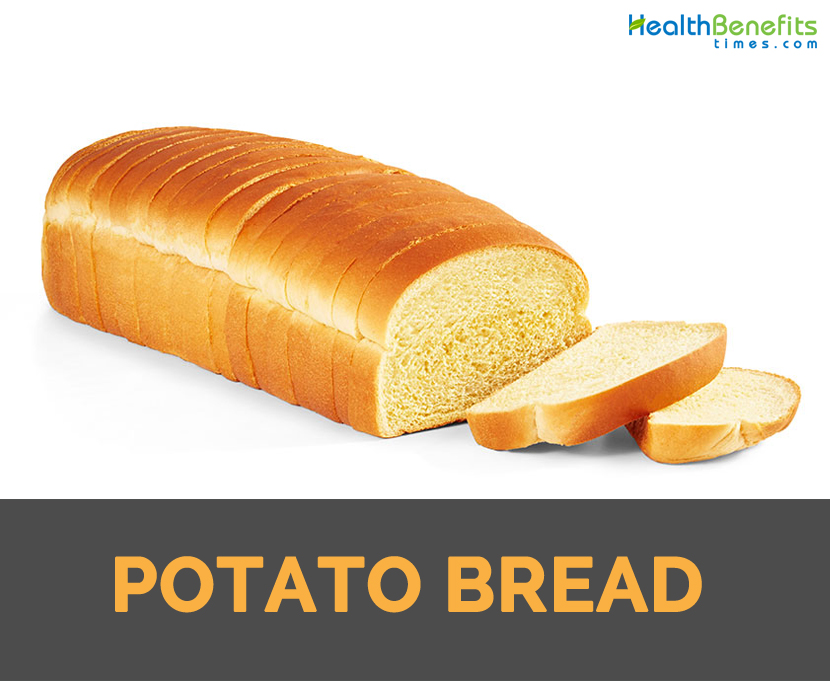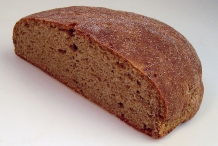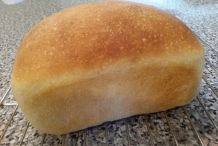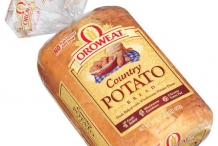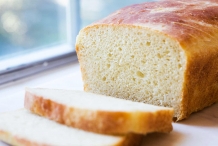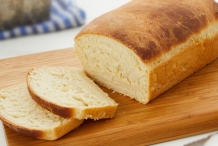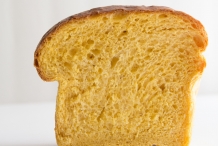The flavor of bread is excellent and remains moist longer in comparison to other but the potatoes used should be good and boiled completely and well dried afterwards by having water poured from them and standing by side of fire to steam and lowered to perfect paste by mashing or rubbed quickly though cullender and other coarse strainer. It should be combined with flour or meal perfectly while they are warm. The addition of more salt than for common bread, dough requires less liquid in comparison to wheat dough and should be made firmly and smoothly and should be managed afterwards like other bread but should be baked in oven more gently.
How to Eat
- Toast it and smother with butter or cheese.
- Serve it with eggs or baked beans.
- Potato bread pairs well with ham or lean chicken.
- Use potato bread to make grilled cheese sandwich.
- Serve a sliced toasted potato bread with peanut butter.
- Brush broiled potato bread with olive oil and top it with garlic (minced).
- Drizzle small pieces of potato bread with dried herbs and olive oil.
Health Benefits of Potato Bread
Some health benefits which could be derived from Potato bread:
- Fiber content
A slice of potato bread offers 2 grams of dietary fiber i.e. more than twice of fiber in white bread. The daily recommended intake of fiber is 30 to 38 grams for men and 21 to 25 grams for women. The addition of fiber to the daily diet assist healthy digestive system and helps to prevent the chances of constipation. Fiber provides long term effects for health. The sufficient amounts of fiber regularly lower the chances of cardiovascular diseases and also reduce the chances of Type 2 diabetes development. Diet rich in fiber controls weight by filling and also preventing overeating.
- Presence of folate
Once slice of potato bread grants 48 micrograms of folate i.e. more than 10 percent of 400 micrograms required on regular basis. It contains twice amount of folate found in a slice of white bread. Folate is a Vitamin B which supports the production and maintenance of cells and is essential during pregnancy. Folate has a vital role in DNA formation and prevents DNA damage that could lead to cancer formation. It also prevents the risk of birth defects and assist the production of red blood cells.
- Free radical damage
A slice of Potato bread offers 0.15 milligrams of Vitamin E which is more than 0.03 milligrams found in slice of white bread. Vitamin E acts as an antioxidant which assists in protecting body from harmful effects of free radicals. Free radicals are responsible for cell damage leading to chronic health problems such as cancer and cardiovascular diseases. Vitamin E assists healthy immune system and also prevents decline in cognition.
Recipes for Potato Bread
-
OLD-FASHIONED POTATO BREAD
Root vegetables were among the first foods to be cultivated, and have long been an essential food source. Potatoes were a staple in the Incan cultures of Peru. They also made the journey to Europe with returning New World explorers, transforming European and eventually North American cuisines forever. It comes as no surprise, then, that this dietary staple has long been used in baking bread. Fresh mashed potatoes add a moist, fluffy texture not comparable to any other ingredient in breads. The complex carbohydrates in the potato make a perfect food for the yeast and the rest is kitchen legend; bread machine bakers love to use the floury potatoes in breads and starters. No matter how large my repertoire of baking gets, potato bread is one of my perennial favorites.
INGREDIENTS:
1 ½ -POUND LOAF
- 1 medium russet potato (8 to 9 ounces), cut into chunks
- 3/4 cup water
- 2 tablespoons unsalted butter, cut into pieces
- 3 cups bread flour
- 1 tablespoon sugar
- 1 ½ teaspoons gluten
- 1 ½ teaspoons salt
- 1 ¾ teaspoons SAF yeast or 2 ¼ teaspoons bread machine yeast
2-POUND LOAF
- 1 medium russet potato (8 to 9 ounces), cut into chunks
- 1 cup water
- 3 tablespoons unsalted butter, cut into pieces
- 4 cups bread flour
- 1 ½ tablespoons sugar
- 2 teaspoons gluten
- 2 teaspoons salt
- 2 ¼ teaspoons SAF yeast or 2 ¾ teaspoons bread machine yeast
Directions:
- Combine the potato and water in a small saucepan. Simmer, covered, until the potato is tender, about 10 minutes; slip off the peels. Mash or puree the potato with its water (do not drainthe water). Pour the potato-water mixture into a 2-cup glass measuring cup and add additional water to make 1 1/3 cups for a 1 ½ -pound loaf or 1 2/3 cups for the 2-pound loaf. Cool to room temperature.
- Place all the ingredients in the pan according to the instructions of manufaturer, adding the potato mixture with the liquid ingredients. Set crust on medium and program for the Basic cycle; press Start. (The recipe is not suitable with the Delay Timer.)
- When the baking cycle finishes, remove the bread immediately from the pan and place it on a rack. Before slicing, let it cool to room temperature.
2. INSTANT-POTATO BREAD
Long ago, Peruvian Indians dried potatoes by stomping on them to press out the moisture, then left them to freeze overnight. The potatoes were later reconstituted in water over a campfire. When vegetables are dried, their vitamins, flavor, and color remain intact. The bread tasted so good, especially the loaves made in the bread machine. The crumb on potato bread is fluffy and dense, the interior moist, and the crust crisp. This loaf can be baked on the Quick Yeast Bread cycle since the potatoes encourage the yeast. (See your manufacturer’s manual for guidelines for adjusting the quantity of yeast when using this cycle.) This is a high-domed loaf. Be sure to add the flour first, to the liquid already in the pan, and then the potato flakes.
INGREDIENTS:
1 ½ -POUND LOAF
- 1/2 cup water
- 2/3 cup buttermilk
- 1 ½ tablespoons olive oil
- 1 ½ tablespoons dark honey
- 2 ½ cups bread flour
- 1/3 cup instant potato flakes
- 1 tablespoon gluten
- 1 ¼ teaspoons salt
- 1 ¾ teaspoons SAF yeast or 2 ¼ teaspoons bread machine yeast
2-POUND LOAF
- 3/4 cup water
- 3/4 cup buttermilk
- 2 tablespoons olive oil
- 2 tablespoons dark honey
- 3 cups bread flour
- 1/2 cup instant potato flakes
- 1 tablespoon plus 1 teaspoon gluten
- 1 ½ teaspoons salt
- 2 teaspoons SAF yeast or 2 ½ teaspoons bread machine yeast
Directions:
- Place all the ingredients in the pan according to the order in the manufacturer’s instructions. Set crust on medium and program for the Basic cycle; press Start. (This recipe is not suitable for use with the Delay Timer.) The dough ball will be nicely formed and slightly sticky but stiff at the same time when tested. It should feel a bit sticky, so take care not to add any more than an extra tablespoon of flour. The potato flakes will soak up the extra moisture during the rises and will become smooth during the risings.
- When the baking cycle ends, immediately remove the bread from the pan and place it on a rack. Let cool to room temperature before slicing.
3. GLUTEN-FREE RICOTTA POTATO BREAD
Potato starch flour makes for exceptionally nice bread.
INGREDIENTS:
1 ½ – OR 2-POUND-LOAF MACHINES
- 1 1/3 cups water
- 3/4 cup ricotta cheese
- 1 teaspoon apple cider vinegar or rice vinegar
- 3 tablespoons vegetable or canola oil
- 3 large eggs, broken into a measuring cup to equal 3/4 cup (add water if needed)
- 2 ¼ cups white rice flour
- 1/2 cup instant potato flakes
- 1/3 cup potato starch flour
- 1/3 cup tapioca flour
- 1/2 cup dry buttermilk powder or nonfat dry milk
- 3 tablespoons sugar or powdered fructose
- 2 teaspoons xanthan gum
- 1 ½ teaspoons salt
- 3/4 teaspoon baking soda
- 2 ¼ teaspoons SAF yeast or 2 ¾ teaspoons bread machine yeast
Directions:
- Place all the ingredients in the pan according to the order in the manufacturer’s instructions. Set crust on medium and program for the Non-Gluten or Quick Yeast Bread cycle; press Start. (This recipe is not suitable for use with the Delay Timer.)
- When the baking cycle ends, immediately remove the pan from the machine and place it on a rack. Let cool for 10 minutes before removing the loaf from the pan. Let the loaf cool to room temperature before slicing.
4. POTATO BREAD WITH CARAWAY SEEDS
The Roman legions brought caraway with them on their treks north when they occupied lands up to the Danube River in their settlement at Aquincum. Perhaps that is when the tradition of baking with caraway seeds began in what is now Hungary. Caraway is one of the four prominent seasonings of Hungarian baking, along with marjoram, dill, and thyme. One of the most famous Hungarian breads is this one, made with potatoes and aromatic caraway seeds. It is served with meals—alongside a good gulyás (beef and green pepper stew), with stuffed cabbage with tomato sauce, or accompanying pork chops baked on a bed of sauerkraut. This is a fast recipe, since you don’t have to cook potatoes to make it. I use a potato water made with instant mashed potatoes, in combination with potato starch flour. If you have potato water left over from making mashed potatoes, please go ahead and use it, leaving out the instant flakes. This is a soft bread with a crisp crust.
INGREDIENTS:
1 ½ -POUND LOAF
- 1 1/3 cups warm water
- 2 tablespoons instant potato flakes
- 1 ½ tablespoons butter or lard
- 2 2/3 cups bread flour
- 1/3 cup potato starch flour
- 1 ½ tablespoons sugar
- 2 teaspoons gluten
- 2 teaspoons caraway seeds
- 1 ½ teaspoons salt
- 1 ¾ teaspoons SAF yeast or 2 ¼ teaspoons bread machine yeast
2-POUND LOAF
- 1 2/3 cups warm water
- 3 tablespoons instant potato flakes
- 2 tablespoons butter or lard
- 3 ½ cups bread flour
- 1/2 cup potato starch flour
- 2 tablespoons sugar
- 1 tablespoon gluten
- 1 tablespoon caraway seeds
- 2 teaspoons salt
- 2 teaspoons SAF yeast or 2 ½ teaspoons bread machine yeast
Directions:
- Place the instant potato flakes in the water in a bowl. Let stand for 5 minutes. The flakes will expand and soften, and the water become cloudy.
- Place the ingredients in the pan according to the order in the manufacturer’s instructions, adding the potato water with the butter or lard as the liquid ingredients. Set crust on dark and program for the Quick Yeast Bread or Rapid cycle; press Start. (This recipe is not suitable for use with the Delay Timer.) The dough ball will be smooth and soft. If the dough rises more than two-thirds of the way up the pan, gently deflate the dough a bit. This will keep the dough from hitting the window during baking.
- When the baking cycle ends, immediately remove the bread from the pan and place it on a rack. Let cool to room temperature before slicing.
5. SWEET POTATO BREAD
This is a surprise bread, bright orange with bits of tart cranberries throughout. Some people like to add 18 cup finely chopped pecans along with the cranberries. It is not a sweet bread, so one can serve it with dinner and for sandwiches. Make the sweet potato puree by putting fresh-baked or leftover baked sweet potatoes through a food mill or a food processor. Or use canned, vacuum-packed sweet potatoes. One 9-ounce can drained and mashed will yield 3/4 cup.
INGREDIENTS:
1 ½ -POUND LOAF
- 1/2 cup fat-free milk
- 3/4 cup pureed sweet potatoes
- 3 tablespoons sour cream
- 3 cups bread flour
- 1 tablespoon gluten
- 1 ½ teaspoons salt
- Grated zest of 1 orange
- 2 teaspoons SAF yeast or 2 ½ teaspoons bread machine yeast
- 2/3 cup fresh whole cranberries
2-POUND LOAF
- 2/3 cup fat-free milk
- 1 cup pureed sweet potatoes
- 1/4 cup sour cream
- 4 cups bread flour
- 1 tablespoon plus
- 1 teaspoon gluten
- 2 teaspoons salt
- Grated zest of 1 orange
- 2 ½ teaspoons SAF yeast or 1 tablespoon bread machine yeast
- 7/8 cup fresh whole cranberries
Directions:
- Place the ingredients, except the cranberries, in the pan according to the order in the manufacturer’s instructions. Set crust on medium and program for the Basic or Fruit and Nut cycle; press Start. (This recipe is not suitable for use with the Delay Timer.) When the machine beeps, or between Knead 1 and Knead 2, add the cranberries; they will break up some with the action of the blade.
- When the baking cycle ends, immediately remove the bread from the pan and place it on a rack. Let cool to room temperature before slicing.
References:
https://www.simplyrecipes.com/recipes/homemade_potato_bread/
https://en.wikipedia.org/wiki/Potato_bread
https://www.foodpower.info/history-potato-bread
https://en.wikibooks.org/wiki/Cookbook:Potato_Bread
https://healthyeating.sfgate.com/potato-bread-healthy-3808.html
Comments
| Potato bread Quick Facts | |
|---|---|
| Name: | Potato bread |
| Colors | White |
| Calories | 85 Kcal./cup |
| Major nutrients | Phosphorus (16.86%) Carbohydrate (11.58%) Vitamin B9 (10.00%) Iron (9.00%) Protein (8.00%) |
| Health benefits | Fiber content, Presence of folate, Free radical damage |
| Name | Potato bread |
|---|---|
| Type | Bread |
| Color | White |
| Main ingredients | Potato, flour, wheat flour |
| Common names | Slims, Fadge, Potato cake, Potato farls, Irish Potato bread |
| Vernacular names | Ireland: Tatie bread; Scotland: Tawty or tattie scone |
| Major Nutritions | Phosphorus, P 118 mg (16.86%) Carbohydrate 15.06 g (11.58%) Vitamin B9 (Folate) 40 µg (10.00%) Iron, Fe 0.72 mg (9.00%) Protein 4 g (8.00%) Sodium, Na 120 mg (8.00%) Vitamin D (Cholecalciferol) 1 µg (6.67%) Calcium, Ca 60 mg (6.00%) Tryptophan 0.026 g (5.91%) Vitamin B6 (Pyridoxine) 0.074 mg (5.69%) |
| Health Benefits |
|
| Calories in 1 slice (32 g) | 85 Kcal. |


